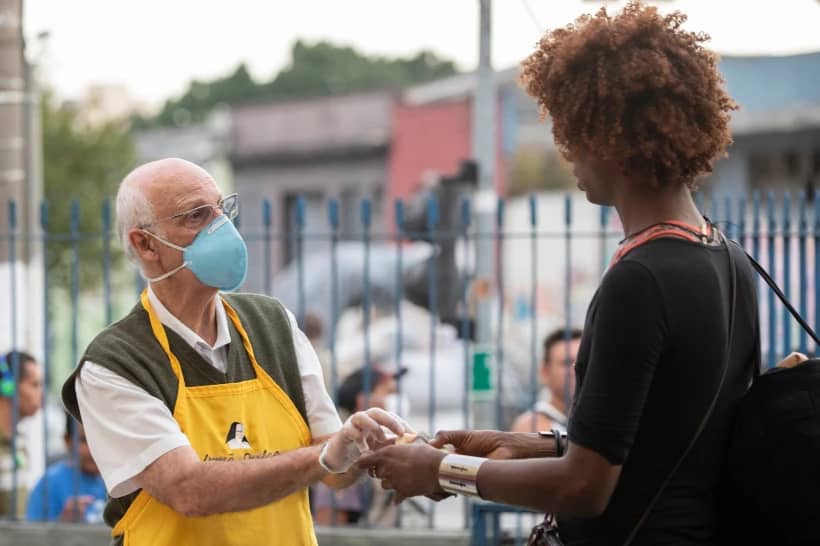It is amazing what a synod can do for a person.
German Bishop Fritz Lobinger, a 90-year-old retired missionary bishop in South Africa, has suddenly become the talk of Rome.
Lobinger’s idea of ordaining “elders” to the priesthood to provide local communities regular access to the sacraments has been the root of discussions about “married priests” that have dominated headlines about the Synod on the Amazon, the three-week summit of bishops which began this week at the Vatican.
This is a pressing issue in the region – some areas have only one priest per 15,000 Catholics, with priests forced to travel by canoe to reach isolated communities. Some people might not see a priest for a year, leaving lay catechists to conduct Sunday scripture services, as well as to preside over baptisms and marriages.
At the same time, there has been strong resistance to the idea of abandoning the rule of celibacy for priests in the Latin Rite.
Lobinger’s revolutionary idea is an attempt to square the circle on the issue.
The bishop – who also faced a lack of priests in his remote diocese – has for decades advocated ordaining married men, or “elders” to the priesthood, but with a twist: They would not be clerics in the ordinary sense.
The “elders,” although technically ordained, would not even be called priests and would work under a series of limitations: They would only be allowed to serve in their local community, would not receive a seminary education, would not wear clerical dress.
In other words, these “elders” would be married men with jobs, taking weekend courses for a couple of years before being ordained.
These “elders” would be guided by the seminary-educated, celibate priests.
(For Americans, the concept has a ring of familiarity, since permanent deacons have a similar background, although they can’t hear confessions or celebrate Mass.)
Lobinger’s idea is a bit of a departure from the traditional idea of viri probati – Latin for “tested men” – where some select older men might be allowed to be ordained to the priesthood without going through the same extensive formation as other priests. This proposition predates the current married priest debate, and was originally proposed for older, celibate men in mission territories who were too old to have gone through a formation process that regularly began when a man was in their early teens. Nowadays, it is used exclusively to refer to married candidates.
The viri probati might labor under certain restrictions – perhaps not allowed to serve as a pastor or even be allowed to preach a homily – but they would still be priests. In many ways, the viri probati are conceptually similar to the “simplex priest” of religious houses before Vatican II, who could celebrate Mass but not hear confessions or preach sermons.
Lobinger instead says there should be two different forms of priesthood, as distinct as possible.
And herein lies the real revolution being proposed.
Although it’s considered the most controversial talking point of the synod, a married priesthood is something the Catholic Church has experience with and understands.
Most of the Eastern Rites have a married clergy, hundreds of clergy converts have become married Catholic priests in the Latin Rite, and in the ecumenical activities, Catholic clergy see their Protestant counterparts living and ministering with their spouses.
Lobinger’s proposal, on the other hand, could radically alter the idea of priesthood as it’s understood in the Catholic Church, even creating a caste system among priests.
“This means that we would have two different forms of priesthood. Both receive the same sacrament of Holy Orders. Theologically speaking both are priests, but in daily life we would always use two different terms: priests and elders,” the bishop wrote in U.S. Catholic in 2010.
“The two kinds would exercise two different roles. The elders would lead the community and administer the sacraments in their own community, while the priests would be the spiritual guides of elders in several self-ministering communities. The priests would thus serve the whole diocese, while the elders would serve only the community where they were ordained. Elders would not be transferred.”
The proposal raises a number of questions, without even mentioning married priests or celibacy.
First and foremost, what does one do with an entrenched “elder” that, in the end, is not a good fit for ministry, especially if he is a popular leader in the community? Lobinger says this can be prevented by only ordaining “ministry teams” to prevent a single figure from gaining too much power, but it is hard to see how this would prevent the problem.
But even if all the practical and legal questions can by answered by the synod fathers, another issue is lurking underneath the proposal, which touches on the colonial history of the Amazon region.
“Elders” would most often represent indigenous communities in a diocese led by a non-indigenous bishop assisted by non-indigenous priests, meaning an uncomfortable racial element would exist among the two classes of priests. The system would have the de facto result of creating an indigenous clergy not allowed to use the titles and dress used by non-indigenous clergy – nor even allowed to exercise their ministry outside of their village.
For indigenous peoples who themselves have often had to suffer under similar restrictions in their daily life, there might be resentment if their “elders” are treated as second-class clerics.
And that is the stuff of actual revolutions.
Follow Charles Collins on Twitter: @CharlesinRome
Crux is dedicated to smart, wired and independent reporting on the Vatican and worldwide Catholic Church. That kind of reporting doesn’t come cheap, and we need your support. You can help Crux by giving a small amount monthly, or with a onetime gift. Please remember, Crux is a for-profit organization, so contributions are not tax-deductible.
















